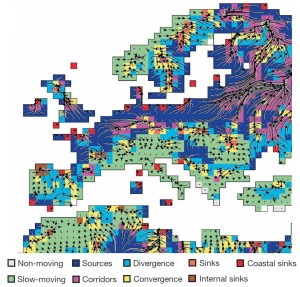Following the climate

International study allows forecast of climate-caused migration of animals and plants
Where do animals and plants have to go to adapt to the new conditions brought by climate change? A team of scientists including FAU researchers has confronted this question. They examined the patterns of temperature changes in the past 50 years in order to be able to predict which regions the various species will migrate to. The study aims to make species conservation more efficient. The researchers recently published their findings in the renowned journal Nature.*
Climate change is a global phenomenon that impacts all animal and plant species. Earth has seen an average rise in temperature of 0.7 degrees Celsius. But not all areas are affected in the same way: some regions have heated up more, others have even seen a drop in temperature. However, something that is far more important for the survival of individual species than the absolute difference in temperature is the direction and speed with which zones of equal temperature are moving across the globe. These two climate vectors – direction and velocity – determine where and how fast species have to migrate in order to maintain the climatic conditions they are used to.
An international team of researchers, among them FAU researcher Prof. Dr. Wolfgang Kießling from the Department of Palaeoenvironmental Studies, has examined these climate trajectories globally for the past 50 years. In order to do so, they divided Earth’s surface into many little squares and noted for each one how the temperature has developed there in the past 50 years. The researchers were then able to use this data to determine the direction and velocity of temperature changes.
No way out: isolated in a climate zone
In their analysis, the researchers identified three different areas: climate sources, climate sinks and climate corridors. Climate sources are regions in which all climate trajectories point outwards: these are regions with a novel climate that does not exist in any of the connecting areas. This means that species will migrate from, but not to this area. The largest climate source can be seen around the equator: here, the temperatures are constantly rising and the animals and plants inhabiting the area are migrating to cooler regions. As the equator is isolated by the connecting cooler regions, no new species can migrate there from other hot areas.
Climate sinks are regions in which the local climate is disappearing completely. They prevent the flora and fauna from migrating to other areas. Mountain ranges are an example of sinks: as we know, the higher the altitude, the colder it gets in the mountains. If the temperatures now rise, the inhabitants of the mountain top or the areas near the top have no way out: in the lower areas it is even warmer and they cannot go further up either. Sinks and sources – which make up as much as 18 percent of Earth’s surface – are where the most species extinctions are expected in the long term, unless those species manage to adapt to the new climate or to follow the climate they are accustomed to.
Climate corridor in southern Germany
Climate corridors are areas in which climatic conditions from various connecting regions converge and eventually continue moving in one direction together. A corridor of global importance can be found in southern Germany. Due to climatic movements, species from different source areas meet in the corridors – with unpredictable consequences: ‘Even if the species can migrate to and from the corridors, the biological diversity in these regions is endangered,’ says Prof. Kießling. ‘When different species come together, there will be winners and losers.’
The determined patterns will be used to make species conservation efforts more efficient. Conservation measures are most likely to succeed where climate change is moving at a slow pace. In sources, sinks and corridors, the danger can only be averted with considerable efforts, for instance by relocating animals and plants to other regions. Which would, in turn, have impossible to predict consequences for the habitats in question.
Further information:
Prof. Dr. Wolfgang Kießling
Phone: +49 (9)131 85 26959
wolfgang.kiessling@fau.de